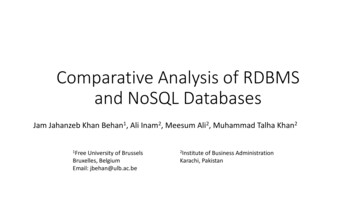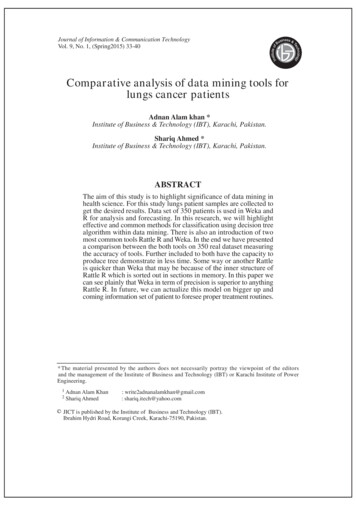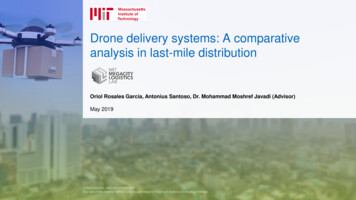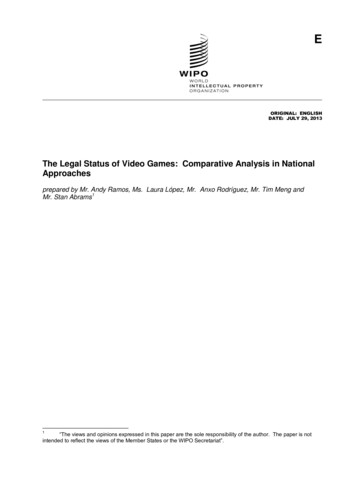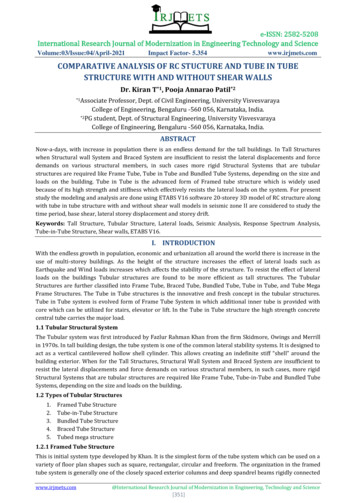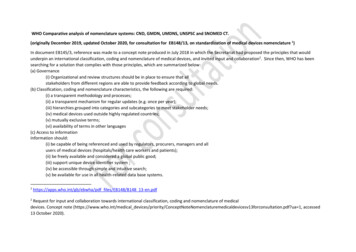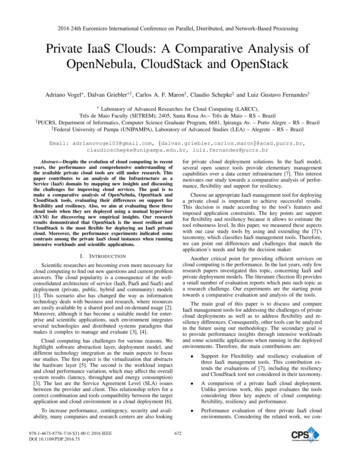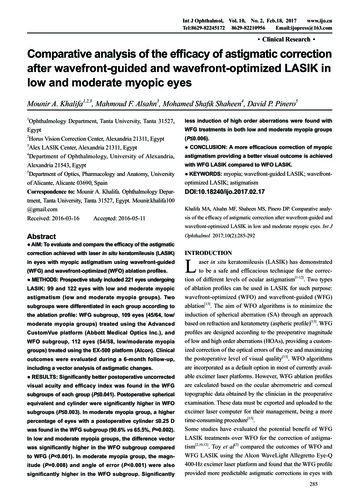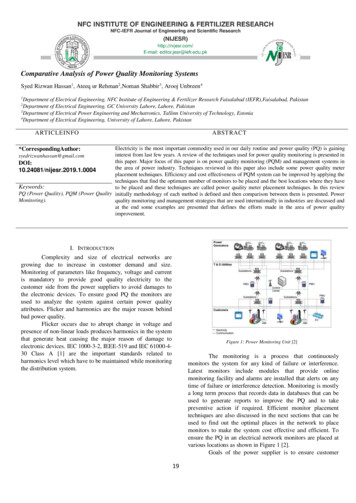
Transcription
Comparative Analysis of Power Quality Monitoring SystemsSyed Rizwan Hassan1, Ateeq ur Rehman2,Noman Shabbir 3, Arooj Unbreen41Department of Electrical Engineering, NFC Institute of Engineering & Fertilizer Research Faisalabad (IEFR),Faisalabad, PakistanDepartment of Electrical Engineering, GC University Lahore, Lahore, Pakistan3Department of Electrical Power Engineering and Mechatronics, Tallinn University of Technology, Estonia4Department of Electrical Engineering, University of Lahore, Lahore, Pakistan2ARTICLEINFOABST RACTElectricity is the most important commodity used in our daily routine and power quality (PQ) is gaininginterest from last few years. A review of the techniques used for power quality monitoring is presented inthis paper. Major focus of this paper is on power quality monitoring (PQM) and management systems inDOI:the area of power industry. Techniques reviewed in this paper also include some power quality meter10.24081/nijesr.2019.1.0004placement techniques. Efficiency and cost effectiveness of PQM system can be improved by applying thetechniques that find the optimum number of monitors to be placed and the best locations where they haveKeywords:to be placed and these techniques are called power quality meter placement techniques. In this reviewPQ (Power Quality), PQM (Power Quality initially methodology of each method is defined and then comparison between them is presented. PowerMonitoring).quality monitoring and management strategies that are used internationally in industries are discussed andat the end some examples are presented that defines the efforts made in the area of power hassan@gmail.comI. INTRODUCTIONComplexity and size of electrical networks aregrowing due to increase in customer demand and size.Monitoring of parameters like frequency, voltage and currentis mandatory to provide good quality electricity to thecustomer side from the power suppliers to avoid damages tothe electronic devices. To ensure good PQ the monitors areused to analyze the system against certain power qualityattributes. Flicker and harmonics are the major reason behindbad power quality.Flicker occurs due to abrupt change in voltage andpresence of non-linear loads produces harmonics in the systemthat generate heat causing the major reason of damage toelectronic devices. IEC 1000-3-2, IEEE-519 and IEC 61000-430 Class A [1] are the important standards related toharmonics level which have to be maintained while monitoringthe distribution system.Figure 1: Power Monitoring Unit [2]The monitoring is a process that continuouslymonitors the system for any kind of failure or interference.Latest monitors include modules that provide onlinemonitoring facility and alarms are installed that alerts on anytime of failure or interference detection. Monitoring is mostlya long term process that records data in databases that can beused to generate reports to improve the PQ and to takepreventive action if required. Efficient monitor placementtechniques are also discussed in the next sections that can beused to find out the optimal places in the network to placemonitors to make the system cost effective and efficient. Toensure the PQ in an electrical network monitors are placed atvarious locations as shown in Figure 1 [2].Goals of the power supplier is to ensure customer19
with the existing Supervisory Control and data acquisition(SCADA). This system also uses global positioning system(GPS) for synchronization [8].satisfaction which can be achieved by providing the powerlevels that are desired by them. So customer’s complaints arethe major factor that drives the suppliers to ensure good powerlevels. V. Becirovic et al. in his paper presented a method thatdivides the customers into three groups based on currentwaveform and the type power they use [3]. This classificationbased system make analysis of system more easy for thesuppliers. The proposed model is voltage dependent with themajor drawback that every time when there is some change inclassification then we have to update the grouping system.e) Integrated Power Quality Monitoring SystemThis monitoring system integrates data from allintelligent devices but it was suggested to collect the dataonly related to disturbance created in the system to identifythe cause that produce such disturbance. The standardfollowed by the devices that are used for power monitoring isIEC610000-4-30. Also Suggestion to allocate high datathroughput for PQM systems is presented in [9].II. DISCUSSIONf) FPGA Based Power Quality MonitoringFor sensitive and high cost user equipment the PQ has tobe maintained and for this purpose we have to implementPQM continuously. S. Folea et al. has designed a FPGAbased system has two analog channels for measuring currentand voltage for PQ analysis and is connected with thecomputer using WiFi module for transmission of acquireddata for further processing. This FPGA board include LCDfor displaying data. This system is not much power efficient,so need further improvements [10].A. Power Quality Monitoring Systems & Techniquesa) t Variations in the voltage of power supply arecalled flickers which introduces interference in electricalnetworks and degrades the power quality [4]. This flicker ismajor source of interference and also causes damage toelectronic equipment attached to such source. High resolutiontechnique uses frequency spectrum analysis to observe andextract the flicker component from the signal. The purpose ofextracting such flicker components is to make strategies andalgorithms to remove such flicker problem to improve thepower quality. This technique uses Pony’s method and ismore accurate. This method is more accurate and robust butmathematically it is more complex [5].g) Power Quality Monitoring Using OPNETOPNET simulator for the analysis of PQM is presentedin [11] by Y. Bi et al. This research explores the importanceof online and real time monitoring of PQ. These type ofsystems need communication systems also so study of severaltype of systems was done and OPNET simulator is used fortheir analysis. It is also found in this paper that 10M Ethernetcable is better for fulfilling the demand of the online PQMsystems.b) S-Transform Based Power Quality AnalysisIn [6] a novel method of PQ analysis is presented thatuses S-Transform based classification. The proposed methodanalyzes the frequency spectrum of signal by finding STransform of signal and was tested to detect some short termvoltage disturbances and tracking their causes. Mathematicalcomplexity of this method is high.h) Spectrum Analysis Based Power Quality MonitoringSystemNormally the data collected from the PQ monitoringsystem is in time domain. Spectrum Analysis is a technique inwhich the time domain data obtained is analyzed afterfrequency domain transform. This spectrum analysis basedsystem is developed by L. Penghui et al. [12]. LabViewanalyzer is used for analysis in this system. For PQmonitoring voltage and current of electrical network isconsidered for distortion created by harmonics. A transformersubstation is tested to analyze the proposed system andanalysis has shown that the proposed system has detected theharmonics and THD in the network.c) Data-Acquisition System for Power Quality Monitoring(SEMCE DAC)The SEMCE DAQ is a data acquisition system designedto measure PQ metrics at smart grids. This system providesreal time monitoring for future improvements. The importantparameters such as voltage, current, frequency, power andharmonics are measured by this system. Computationalaccuracy and performance of this system is very good. Due toits low cost and data transmission capability it is suggested toimplement this system in current smart grids for PQM [7].i) Power Quality Monitoring Using Pseudo-MeasurmentsTo identify the power quality issues in a large scaledistribution networks the pseudo-measurements method isused. S. R. K. Kanaesalingam et al. applied an intelligentapplication based on pseudo-measurement to find the powerquality in 33KV distribution network.d) Power Quality Monitoring System Over the InternetThis system merges the PQM systems with the internet usingcomputers, web servers and communication systems totransmit the high quality and large size data over thecommunication line. M. Zhang and Kaicheng Li investigatedthis system for PQM and research have shown that thissystem is efficient, low cost and is compatible to implementj) Co-Operative Sensor Network for Power Quality20
MonitoringIn this PQM system the wireless sensor nodes are usedfor quality monitoring. This is a distributed system and mainfeatures of this system includes scalability and selforganization. Advantage of this system includes the access toany node at any time to acquire data.Voltage is very important PQ factor. To have a better PQ wehave to make sure the monitoring of voltage levels. A systemis presented in [13] which monitors voltage quality usingsensor motes.C. Comparison Between Different Power Quality MonitoringTechniquesPower quality monitoring techniques and power qualitymonitor placement methods are discussed respectively in sectionB and section C. PQM techniques vary in their workingalgorithms, PQ parameters they measure, size of networks onwhich they operate and their complexity. After going throughseveral PQM techniques it is possible to understand the basicoperation of these technique and a comparative analysis ispossible after reviewing these techniques. Table 1 below show acomparison between different PQM and PQ meter placementtechniques.k) Web-Services Framework for Power Quality MonitoringF. Gomez et al. presented an idea to use web servicesplatform for online power quality monitoring and processingthe data that is collected by monitors. This system determineswhether any disturbance in power quality is produced or notafter analyzing the signal collected form the smart meters andafter that location is identified on which any fault is detected.This web based forum can be used for data collection, faultdetection, diagnosis and real time monitoring. The proposedsystem is tested and results have shown that the proposedsystem can be implemented for PQ measurements in realenvironments. Further improvements that are required in thissystem is to make this system more secure [14].SEMCE DAC, the PQM method proposed by S. D.Grigorescu et al. [7] is considered to the best one as it is a lowcost and flexible system that monitors multiple PQ attributes andprovide both real-time and long-term monitoring.TABLE 1. Comparison between PQM systemsNo.PQM MethodAdvantagesDisadvantages1High resolutiontechnique forflickermeasurementS-transformtechniques for PQsignals detectionand analysisAta- acquisitionsystem for PQmonitoring (SEMCE- DAC)PQ monitoringsystem over theinternetIntegrated PQmonitoring systemPQ measurementsystem using cyMathematicalComplexityReduced Cost DataTransmissionCapabilities SystemflexibilityLow cost Could beimplemented overSCADADataTransmission7PQ monitoringusing OPNETOnline Monitoring8PQ monitoringSystem usingspectrumAnalysisPQ monitoringusing PseudomeasurementsCo-operativesensor networkfor PQ monitoringWeb-servicesframework for PQMonitoringOptimal PQ meterplacementBinary ility to analyze largeareasMathematicalComplexityVoltage currentScalable and Selforganizing methodExpensive toolsVoltageGood Operation timeComplexityVoltage sagSpeedAccuracySolving the multiobjective optimizationproblem for OPQMReduce uncertaintyover non- mplexity23B. Meter Placement Techniquesa) Optimal Power Quality Meter PlacementTo reduce the cost of PQM systems this method choosesmeter placement points using adaptive quantum-inspiredbinary gravitational search algorithm(QBGSA) which is moreaccurate and fast as compared to previously developedalgorithms. This system also reduces the redundant datameasurements [15].456b) Binary Firefly AlgorithmThis algorithm uses numbers of monitors needed,monitor coverage area and sag propagation index as objectivefunctions for optimum monitor placement selection [16]. Thisapproach is applied on IEEE 118 bus system and results haveshown that this function can be used for optimum monitorplacement selection in PQM systems.910111213c)Intelligent Meter Placement MethodFor PQ measurements in smart grids an intelligent meterplacement method was proposed by S. Ali et al. [17] which isbased on data driven network system resulting in reduction ofuncertainty in PQ values on power links that are notmonitored properly. Best monitor placement links areidentified using algorithm based on Bayesian network modelsand entropy based measurements. The results have shownthat the prediction error based algorithm developed achievedbetter results. Improvements are required to make itapplicable for large scale networks, running time of thealgorithm also has to be reduced and addition of someevaluation method to find optimum number of monitors to beused for PQM is to be there.14Intelligent meterplacement methodEfficiencyEasy to implementCheapSecurityCost of smartmetersDifficult systemto handle (powerconsumption andStorage issues)Absence of long –term monitoringRunning time notvery goodMonitored PQAttributesFlickerVoltage sag,swell andinterruptionTHDVoltage,current,frequency &harmonics, THDCurrent voltageVoltageharmonicsVoltage CurrentTransmissiontime of somePQ attributeswas measuredHarmonicsTHD--D. Power Quality Monitoring Policies and PracticesWorldwide efforts have been made to ensure the good qualityof power from supplier to receiving end. J. V. Milanovicconducted a survey regarding industry practice about PQM in 43countries using a questionnaire. Response from 114 powercompanies is recorded and it is observed that most of them havecontrol centers to continuously monitor the status of power qualitymonitors to ensure better power quality. Survey shows that aroundthe world these power quality schemes are almost same withminor changings. Important finding of this survey are listed21
below:III. CONCLUSIONSThis paper presents an overview of several modernpower quality monitoring techniques and power qualitymonitor placement techniques. Also research done before todevelop the efficient ways to improve PQM and PQ monitorplacement methods is also helpful in improving the PQMsystems. Important power quality attributes include flickers,harmonics, voltage sags and etc.Both real-time monitoring and long-term monitoringsystems or both are studied in this research. A comparison ispresented in tabular form between different power qualitymonitoring systems on the basis of advantages,disadvantages, attributes they count for PQ measurementsand mathematical complexity. Beside that comparison acomparison between monitor placement techniques is alsopresented.Among all the PQM systems that are compared in thispaper, SEMCE DAC is found to be the most effective, costefficient and flexible method. By incorporating wirelesscommunication technology in PQM systems make it possibleto access the monitoring systems from far away. Mostly fixed monitors are used by transmission systemoperators (TSOs) and portable monitors are mostly used bydistribution system operators (DSOs) and 82% of systemoperators are using fixed monitors for continuously PQ check. Customer complaints are the primary motivation for PQmonitoring.Location of Permanent monitor installation is majorlydependent upon customer PQ requirements.Purchasing of Monitors is majorly dependent on itsperformance, number of input channels, data output ccompatibility and cost.Each individual utility uses only few different modelsof PQ monitorsWhile carrying out measurements, overall system currentis considered rather than a specific customer current andall three phases are monitored.The results of data processing are used for internal orexternal reporting on specific eventsTwo thirds of voltage measurements are line-to- naturalvoltages rather than line to line voltages.REFERENCESEuropean energy regulators through their branchorganizations CEER and ECRB [18] published the guidelines thatcontains some general recommendations about monitorplacement, parameters selection and result reporting.E.[1] J. M. J. V. Milanovic, R. F. Ball, W. Howe, R. Preece, M. H. J.Bollen, S. Elphick and N. Cukalevski, "International IndustryPractice on Power-Quality Monitoring " IEEE Transactions onPower Delivery, vol. 29, pp. 934-941, 2014.[2] B. A. Ahmed, H.H. Elsheikh, A. Fadoun, "Review of power qualitymonitoring systems", Int. Conf. on Industrial Engineering andOperations Management, pp. 592-598, March 2015.[3] B. N. V. Becirovic, S. Hanjalic, M. Brkic, "Modeling a Group ofConsumers in Order to Analyze Power Quality," IEEE BH Section,pp.1-7, 2013.[4] Y. C. a. C.-N. C. Cheng-I Chen, "A High-Resolution Technique forFlicker Measurement in Power Quality Monitoring," presented at the8th Conference on Industrial Electronics and Applications (ICIEA),Taiwan, 2013.[5] A. R. A. N. H. T. Huda, M. H. Jopri, "Power Quality SignalsDetection Using S-Transform," presented at the 7th InternationalPower Engineering and Optimization Conference, Langkawi,Malaysia, 2013.[6] S. Zhang, P. Li, L. Zhang, H. Li, W. Jiang, Y. Hu, "Modified Stransform and ELM Algorithms and their applications in powerquality analysis", neurocomputing, vol. 185, no. 12, pp. 231-241,April 2016.[7] O. M. G. S.D. Grigorescu, C. Cepisca, A.S. Vinyea, "Power QualityMonitoring Systems for Smart Grid Networks," The 8th InternationalSymposium on advanced topics in Electrical Engineering, May 2325, 2013.[8] M. Z. a. K. Li, "A Power Quality Monitoring System over theInternet," The 1st International Conference on Information Scienceand Engineering (ICISE2009), 2009, P1577-1580.[9] A. B. M. Music, N. Hasanspahic, S. Avdakovic, E. Becirovic,"Integrated Power Quality Monitoring System and the Benefits ofStruggles Regarding Power Quality ImprovementPower quality improvement strategies are applied continuouslyto improve the PQ. In many countries new technologies of powerquality monitoring like smart meters are implemented andcontinuous online power quality monitoring techniques areimplemented. P. Santarious presented a long term power qualitymonitoring method [19], in which continuous power quality inmonitored for a period of 12 years(1997-2005) by consideringimportant power quality parameters like harmonics, unbalanceand flicker. After analysis it was found that the major factor inpower quality disturbance is flicker.L. Campus found that flicker occurred many times due toconstruction work and industrial load and some voltage dips areoccurred as a result of lightening in his research done atPortuguese electricity and transmission grid from 2010 to 2011 bycontinuously measuring voltage at delivery points [20].S. Sultan et al. analyzed electrical distribution networks ofLibya in terms of PQ. The research also describes the majorsources causing PQ disturbances and their solutions. It was foundin this research that lack of awareness is also a major cause of PQissues in less developed countries.22
[10][11][12][13][14]Integrating Smart Meters," Public Electric Utility Elektroprivreda ofBosnia and Herzegovina, pp. 86-91, 2013.G. D. Mois, M. Hulea, S. Folea, and L. Miclea, "Self-healingcapabilities through wireless reconfiguration of fpgas," in 9th EastWest Design & Test Symposium (EWDTS), pp. 22-27, 2011.Zhang Lin, Guang Genzhi, Zhang Kai, etc, "Distributed powerquality monitoring system based on virtual instrument andCORBA", Electric Power Automation Equipment, Vo.126, No.2,Feb.2006, pp.83-85.Z. L. Li Penghui, Bai Haijun, Zhang Yanhua, "Power QualityMonitoring of Power System Based on Spectrum Analysis," Schoolof Information Technology, Shenyang University of ChemicalTechnology, pp. 1-4, 2010 2010.K. Zhu, W. K. Lee,
k) Web-Services Framework for Power Quality Monitoring F. Gomez et al. presented an idea to use web services platform for online power quality monitoring and processing

